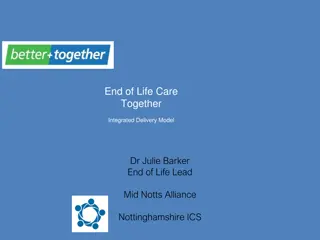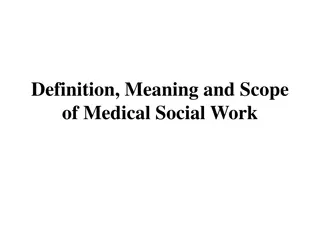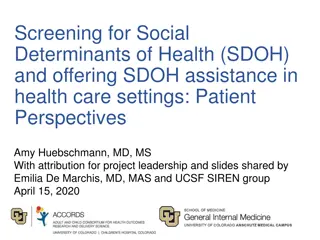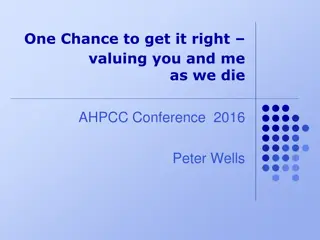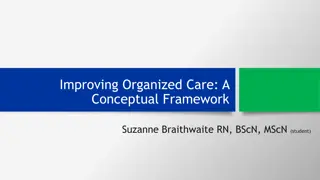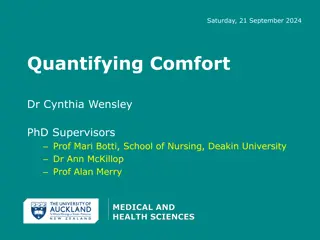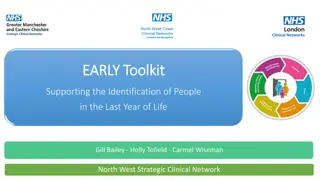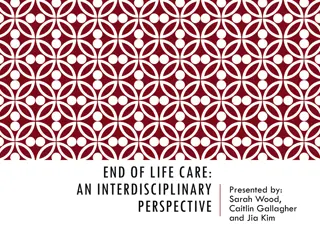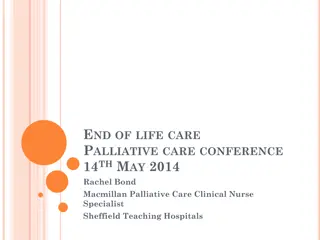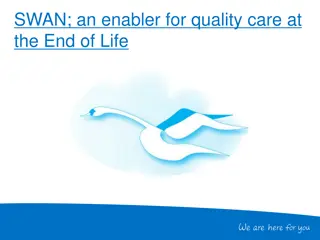End-of-Life Care Insights and Challenges in Healthcare Settings
Understanding end-of-life care dynamics is crucial in healthcare. Data shows a significant portion of hospital days are used in the last year of life, with varying preferences for place of death. Patient factors, care factors, and healthcare factors all influence end-of-life experiences. Challenges include identifying patients with special needs, communication gaps, and training medical teams for better care provision.
Download Presentation

Please find below an Image/Link to download the presentation.
The content on the website is provided AS IS for your information and personal use only. It may not be sold, licensed, or shared on other websites without obtaining consent from the author. Download presentation by click this link. If you encounter any issues during the download, it is possible that the publisher has removed the file from their server.
E N D
Presentation Transcript
30% of acute hospital days used by patients in the last year of life 75% of people will be admitted to hospital in the last year of life Location of deaths in Scotland: Acute setting Home Hospice 52.3% 30.3% 17.4% (Sharpe et al, BMJ Supportive and Palliative Care 2015) (Decreasing) (Increasing) (Increasing) On a given day in Scottish hospitals: 10, 743 people were in-patients in the acute setting 28.8% of those admitted died within the next year 9.3% died during that admission (Clark et al, Pal Med 2014)
Home Hospital Care Home Hospice EOLC outstanding or excellent 53% 33% 51% 59% EOLC Good 28% 36% 33% 26% EOLCGood to outstanding 81% 69% 84% 85% Treated with dignity 72-78% 56.8% 61.4% 80-86% Pain relieved all of the time 19% 39% 46% 63% National Survey of Bereaved People in England (ONS, 2013b)
70-75% Home 4% 1% Many no preference Hospital Care Home Policy focus on improving figures of EoLC at home ... or in a homely setting
Is home always the best and preferred place of death? BMJ 2015;351:h4855 Pollock K Oversimplified Often no option for it depends or it doesn t matter Location a lower priority Comfort and not being a burden more important Usually healthy people surveyed Decreases with age and increasing ill health Lower in patient with non-malignant conditions Carers views different Home environment changes Guilt for carers if not achieved Focus on experience not place
Patient factors o Uncontrolled symptoms o Progression of disease o Intercurrent illness Care factors o Social isolation o Carer distress/fatigue o Care availability- especially overnight Healthcare factors o Skills of team o Feeling of safety o Out of hours
Identification of patients with needs SPICT, GSF Identification of patients with specialist needs Difficulty standing back in acute hospitals Uncertainty What is the aim of care? Communication Changing clinical teams Environment Skills Training for hospital medical teams- 2/3 said they need more Communication skills for prognosis/goals of care conversations Confidence with analgesia
Ellershaw et al, Palliative Medicine, Vol 9, Issue 2, 1995 HPCT involvement Kings College Hospital, London 125 hospital inpatients Significant improvements in symptom control Pain, nausea, insomnia, anorexia Improved understanding of diagnosis and prognosis
Hairmyres Hospital- Mar June 2018 Aim to improve delivery of palliative care in AMRU HPCT involved earlier in admission Early holistic assessment of needs Help define goals of care EOLC support for patients, carers and staff Get patient to most appropriate place of care sooner Education and feedback for medical and nursing staff Proactive daily visit from HPCT to medical receiving ward Similar project in Ninewells Hospital, Dundee 2016
Increased medical sessions From 2 per week to 5 (consultant or experienced specialty doctor) Attend after post-receiving ward round Discuss with AMRU medical team and senior nurses to identify patients with palliative care needs Review or advise as needed Run in period then data collection for 8 weeks Record data on all HPCT referrals admitted through AMRU Compared to corresponding 8 weeks 2017
Length of time from admission to referral/review Reason for referral to HPCT Length of hospital stay Outcome- died, discharged, transfer Intervention by HPCT Investigation rates Readmission rates Place of death
2018 2017 Number of patients referred to HPCT 64 24 Age (mean, years) 71 71 Female sex 45 58 % with non-malignant disease 89% 79%
2018 2 2017 7 Time from admission to HPCT referral (median, days) Time from admission to HPCT review (median, days) 2 10 % of patients referred directly from AMRU rather than later in admission 66% (42 pts) 52% 13% (3 pts) 17% % of patients seen within 48hrs of admission
2018 2017 Length of hospital stay, all medical HPCT referrals (median, days) 8 26 -excluding patients who died in hospital 8 18 -patients admitted to medical ward from AMRU 13 18 Discharged/transferred directly from AMRU % 34% 0%
2018 2017 Readmitted within 8 weeks of end of study period % 21% 29%
2018 6 2017 11 Duration of involvement (median, days) Total days of HPCT involvement 384 264
2017 2018 - All Patients 2018- Patients seen in AMU Acute Hospital 58% 53% 36% Home 24% 30% 42% Hospice 12% 13% 21% Other Hospital 6% 3% -
Improved links between HPCT and medical team Increased referrals for outpatients? Integration of HPCT Improved communication with community HPCT Referrals both ways
Those not seen in AMRU moved out before am reviews weekend admissions new diagnosis/change in aim of treatment during admission
PEOLC is big business in acute hospitals This approach delivered Holistic HPCT review more quickly Fewer days in acute hospital Reduced re-admission rate Patients less likely to die in acute hospital Similar results seen in Tayside Goals consistent with Realistic Medicine Important for patients with life-limiting illnesses
Application to repeat project in University Hospital Wishaw Experienced CNS Present results to SPIG Lobby for increased resource to continue Overall cost-saving?

 undefined
undefined







